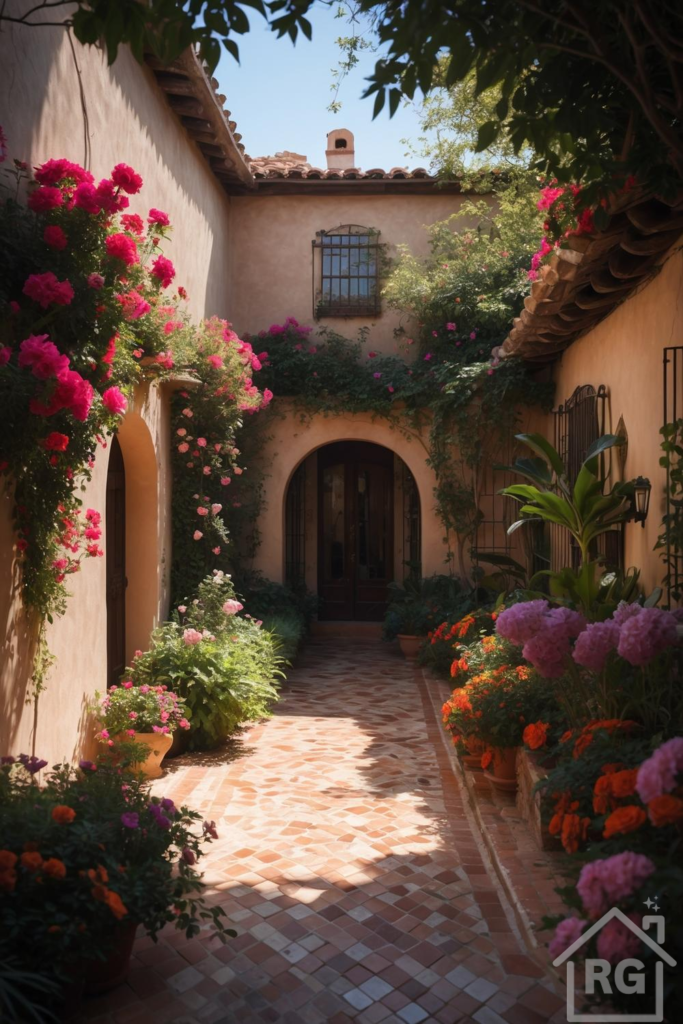
Imagine stepping into a tranquil haven, bathed in warm sunlight, where vibrant flowers cascade down sun-kissed walls and the air is filled with the sweet scent of blossoms. This is the essence of a Mediterranean courtyard – a timeless outdoor space that blends architectural beauty with lush, natural elements.
The inspiration image perfectly encapsulates this dream: a narrow, inviting pathway paved with rustic terracotta tiles, flanked by an explosion of fuchsia and pink blooms, leading to an arched wooden door. The stucco walls, in their earthy tones, provide a perfect backdrop for the rich tapestry of green foliage and colorful flowers.
If you’ve ever dreamed of replicating this serene and vibrant atmosphere in your own backyard, patio, or even a small balcony, this guide will walk you through the essential elements to bring that vision to life.
Laying the Foundation: Architectural Elements and Hardscaping
The bones of a Mediterranean courtyard are its architectural features and hardscaping. These elements provide the structure and character, setting the stage for the botanical beauty to follow.
Walls and Plasterwork
The warm, inviting walls are a hallmark of Mediterranean design. Typically, these are rendered in stucco or plaster, offering a soft, textured finish. To achieve this look, consider:
- Color Palette: Opt for earthy, sun-baked tones. Think creamy off-whites, sandy beiges, warm ochres, or soft terracotta oranges. These colors reflect light beautifully and create a sense of warmth and spaciousness. Avoid stark whites or cool grays.
- Texture: Stucco provides a lovely, slightly uneven texture that adds to the old-world charm. If a full stucco application isn’t feasible, consider textured paints or even a lime wash for a similar effect.
- Vines and Climbers: Encourage climbing plants like bougainvillea or climbing roses to grow directly on the walls (with proper support) or cascade from pergolas. This softens the hard lines and integrates the architecture with nature.
Pathways and Flooring
The pathway in our inspiration image, with its intricate pattern of terracotta tiles, is both functional and aesthetically pleasing. Terracotta and clay pavers are ideal choices for Mediterranean courtyards due to their durability, natural warmth, and rustic appeal.
- Material Choices:
- Terracotta Tiles/Pavers: These are the quintessential choice. They come in various shades of reddish-brown and can be laid in numerous patterns, such as herringbone, basketweave, or simple running bond, as seen in the image. Ensure they are suitable for outdoor use and sealed against moisture.
- Natural Stone: Limestone, travertine, or sandstone in warm tones can also work well, offering a more refined but still earthy feel.
- Gravel: For a more informal or permeable surface, decomposed granite or small pea gravel can be used, often edged with stone or brick.
- Pattern and Layout: The pattern of your pathway can add significant visual interest. A simple grid or a more complex interlocked design can define the space and guide the eye. Consider how the path integrates with planting beds or seating areas.
Arches, Windows, and Doors
Architectural details like arched doorways and windows with wrought iron grilles contribute immensely to the Mediterranean aesthetic. If you have existing structures, consider:
- Arched Openings: If renovating, incorporating arched doorways or passages can instantly transport your space. For existing rectangular openings, consider adding decorative archways or even painting a trompe l’oeil arch.
- Wrought Iron: Decorative wrought iron grilles on windows, gates, or even as purely ornamental wall hangings add an authentic touch. Their dark, intricate patterns contrast beautifully with the light-colored walls.
- Wooden Doors: A solid, rustic wooden door, perhaps with some detailing or a dark stain, completes the look of an inviting entrance.
Cultivating the Greenery: Plant Selection and Arrangement
The lush, vibrant plant life is what truly brings a Mediterranean courtyard to life. The key is to select plants that thrive in similar conditions (often sunny and relatively dry) and arrange them to create a sense of abundance and natural beauty.
Star Performers: Climbing Plants
The cascading flowers in the image are likely bougainvillea or climbing roses, both iconic Mediterranean plants.
- Bougainvillea: Known for their spectacular, papery bracts in brilliant fuchsia, pink, purple, orange, and red. They love full sun and well-drained soil. Provide a sturdy trellis or wires for support, or let them spill over walls and pergolas.
- Climbing Roses: Offer classic beauty and often a delightful fragrance. Choose varieties that are heat-tolerant and disease-resistant for your climate.
- Jasmine: For intoxicating fragrance, especially in the evenings. Star Jasmine (Trachelospermum jasminoides) is a popular choice, with its glossy evergreen leaves and fragrant white flowers.
- Wisteria: If your climate allows, wisteria’s dramatic purple or white flower clusters are breathtaking, though they require very strong support.
Potted Perfection: Container Gardening
Potted plants are essential for adding layers of color, texture, and flexibility to your courtyard. Terracotta pots are the traditional choice, enhancing the rustic charm and providing good drainage.
- Flowering Plants:
- Hydrangeas: While often associated with cooler climates, some varieties can thrive in partial shade in warmer regions, offering large, colorful blooms in pinks, purples, and blues.
- Geraniums (Pelargoniums): Classic Mediterranean patio plants, available in a wide range of colors (red, pink, white) and tolerant of heat and sun.
- Marigolds: Provide cheerful bursts of orange and yellow, thriving in sunny spots.
- Petunias and Verbena: Excellent for spilling over the edges of pots, adding continuous color.
- Fragrant Herbs and Edibles:
- Lavender: Iconic for its purple spikes and calming fragrance, also drought-tolerant.
- Rosemary: A hardy evergreen herb that can be shaped and provides a wonderful aroma.
- Citrus Trees: Dwarf lemon, orange, or kumquat trees in large pots add a touch of luxury and provide fragrant blossoms and fruit.
- Olive Trees: Small olive trees in containers evoke the Mediterranean landscape beautifully.
- Foliage Plants:
- Ferns: For shadier corners or to add lush green texture.
- Succulents and Cacti: Excellent for very sunny, dry spots, offering unique forms and requiring minimal water.
- Agave and Yucca: Provide architectural interest with their bold forms.
- Arrangement Tips: Group pots of varying sizes and heights to create visual interest. Place taller plants at the back and shorter, spilling plants at the front. Consider the sun exposure of different areas of your courtyard when placing plants.
Setting the Mood: Ambiance and Decor
Beyond the plants and structures, it’s the subtle touches that transform a courtyard into a truly inviting oasis.
Lighting
Effective lighting can extend the enjoyment of your courtyard into the evening, creating a magical atmosphere.
- Wall Sconces/Lanterns: As seen in the image, traditional wall-mounted lanterns with a warm glow enhance the old-world charm.
- String Lights: Drape warm white string lights across the courtyard or along walls for a festive, intimate feel.
- Uplighting: Use discreet spotlights to highlight architectural features or the canopy of a beautiful tree.
- Candle Lanterns: Place hurricane lamps or decorative lanterns with LED candles on tables or along pathways for soft, flickering light.
Water Features
The gentle sound of water can be incredibly soothing and cooling in a warm climate.
- Small Fountain: Even a modest wall-mounted or freestanding fountain can add a sensory dimension to your courtyard.
- Bird Bath: A simple bird bath can attract local wildlife and add a peaceful element.
Seating and Comfort
While the image focuses on the pathway, a Mediterranean courtyard is meant to be enjoyed. Integrate comfortable seating where space allows.
- Bistro Set: For smaller courtyards or balconies, a small wrought iron or mosaic-topped bistro table with two chairs is perfect for morning coffee or an evening drink.
- Bench: A stone or wooden bench tucked into a quiet corner offers a spot for reflection.
- Floor Cushions: For a more relaxed, bohemian vibe, scatter large, colorful floor cushions.
- Shade: Consider a retractable awning, a large umbrella, or a small pergola draped with vines to provide respite from the sun.
Decorative Accents
These elements add personality and reinforce the Mediterranean theme.
- Ceramic Pottery: Beyond plant pots, decorative ceramic bowls, plates, or vases in vibrant blues, greens, and yellows can add pops of color.
- Mosaic Art: A small mosaic table top, stepping stones, or a wall panel can be a stunning focal point.
- Rustic Elements: Old wooden crates, vintage watering cans, or even a repurposed olive oil amphora can enhance the rustic charm.
DIY Ideas to Get Started
You don’t need a massive budget or a team of professionals to begin creating your Mediterranean oasis. Many elements can be tackled as DIY projects:
- Painting Walls: A fresh coat of paint in an earthy tone can instantly transform the feel of your outdoor walls.
- Container Gardening: This is the easiest and most impactful DIY. Purchase terracotta pots and fill them with your chosen flowering plants, herbs, and small trees. Experiment with different arrangements.
- Installing Trellises: Simple wooden or metal trellises can be easily installed to support climbing plants.
- Laying Simple Pavers: For a small section, you can lay individual terracotta pavers over a prepared base.
- Creating a Mosaic: Start with a small project like a mosaic stepping stone or a decorative pot.
Maintenance for Lasting Beauty
A beautiful garden requires ongoing care, but many Mediterranean plants are relatively low-maintenance once established.
- Watering: While many Mediterranean plants are drought-tolerant, potted plants will require more frequent watering, especially during hot, dry periods. Use a good quality potting mix that drains well.
- Pruning: Regular pruning will keep climbing plants tidy and encourage more blooms. Deadhead flowering plants to promote continuous flowering.
- Fertilizing: Feed potted plants periodically during their growing season.
- Pest and Disease Control: Keep an eye out for common garden pests and address them promptly using organic or appropriate treatments.
- Winter Protection: If you live in a colder climate, you may need to bring tender potted plants indoors or provide winter protection.
Your Mediterranean Dream Awaits
The beauty of a Mediterranean courtyard lies in its ability to transport you to a sun-drenched landscape, offering a sense of peace and vibrant life. By focusing on warm architectural tones, rustic hardscaping, and a generous array of heat-loving, colorful plants, you can create a space that feels both ancient and eternally inviting.
Whether you have a sprawling yard or a compact balcony, the principles remain the same: embrace natural materials, celebrate abundant flora, and infuse your space with warmth and charm. Start small, add elements gradually, and watch as your outdoor area transforms into your very own Mediterranean oasis. Get ready to relax, entertain, and simply bask in the beauty of your new outdoor sanctuary!
